As fellow dog owners and caregivers to a large extended canine family at Benafim Dog Shelter, we understand the endless quest for durable toys. How many times have you excitedly brought home a new toy, only to find it in pieces within minutes? That sigh of frustration is a familiar one. We’ve been there, testing hundreds of toys with our expert panel – the dogs themselves! They know a thing or two about what truly stands up to a determined chewer.
We’re here to share our honest, reliable, and trustworthy feedback on five popular toys often marketed as “indestructible.” Our shelter dogs, including powerful chewers like Nero, Max, Maya, Black Nero, Jean, and Pebbles, put these toys through a rigorous week-long trial. Their unfiltered opinions will help you navigate the vast world of dog toys, especially when searching for the best dog toys for aggressive chewers to keep your canine companion happy and engaged.
Real, Honest, and Reliable Reviews From Our Canine Experts
We purchased five supposedly indestructible toys for this comprehensive review: the Nylabone Extreme Tough Dog Chew Toy, the Kong Rewards Ball, the CyunCmay Indestructible Dog Toy Bone, the HETOO Indestructible Squeaky Dental Care Dog Toy, and the Kong Wobbler. Over the course of a week, these toys were subjected to intense chewing, playful antics, water submersion, burying, and retrieving. Let’s dive into what our discerning dogs had to say about each one.
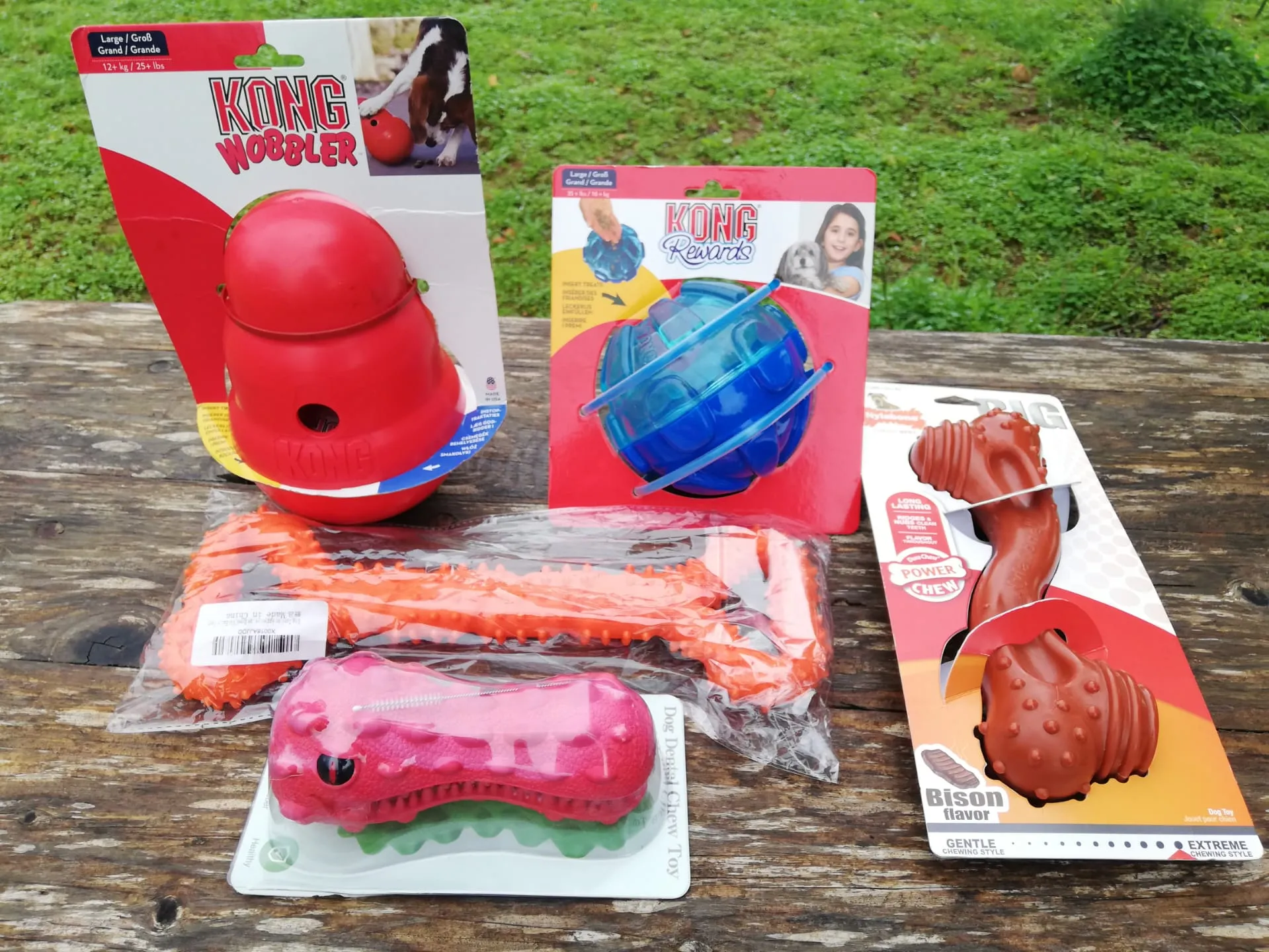 Five supposedly indestructible dog toys laid out for testing
Five supposedly indestructible dog toys laid out for testing
Nylabone Extreme Tough Dog Chew Toy
This XXL Bison-flavored Nylabone Extreme Tough Dog Chew Toy claims to be perfect for the most powerful chewers and dogs weighing over 23kg. Our 9-year-old Pitbull, Nero, who is arguably more intelligent than his human counterparts, spent hours meticulously chewing on this toy, yet barely left a mark. Its generous size is ideal for larger breeds, but it remains light enough for dogs to carry comfortably. The slightly curved design makes it easy for paws to grip, enhancing the chewing experience and overall satisfaction.
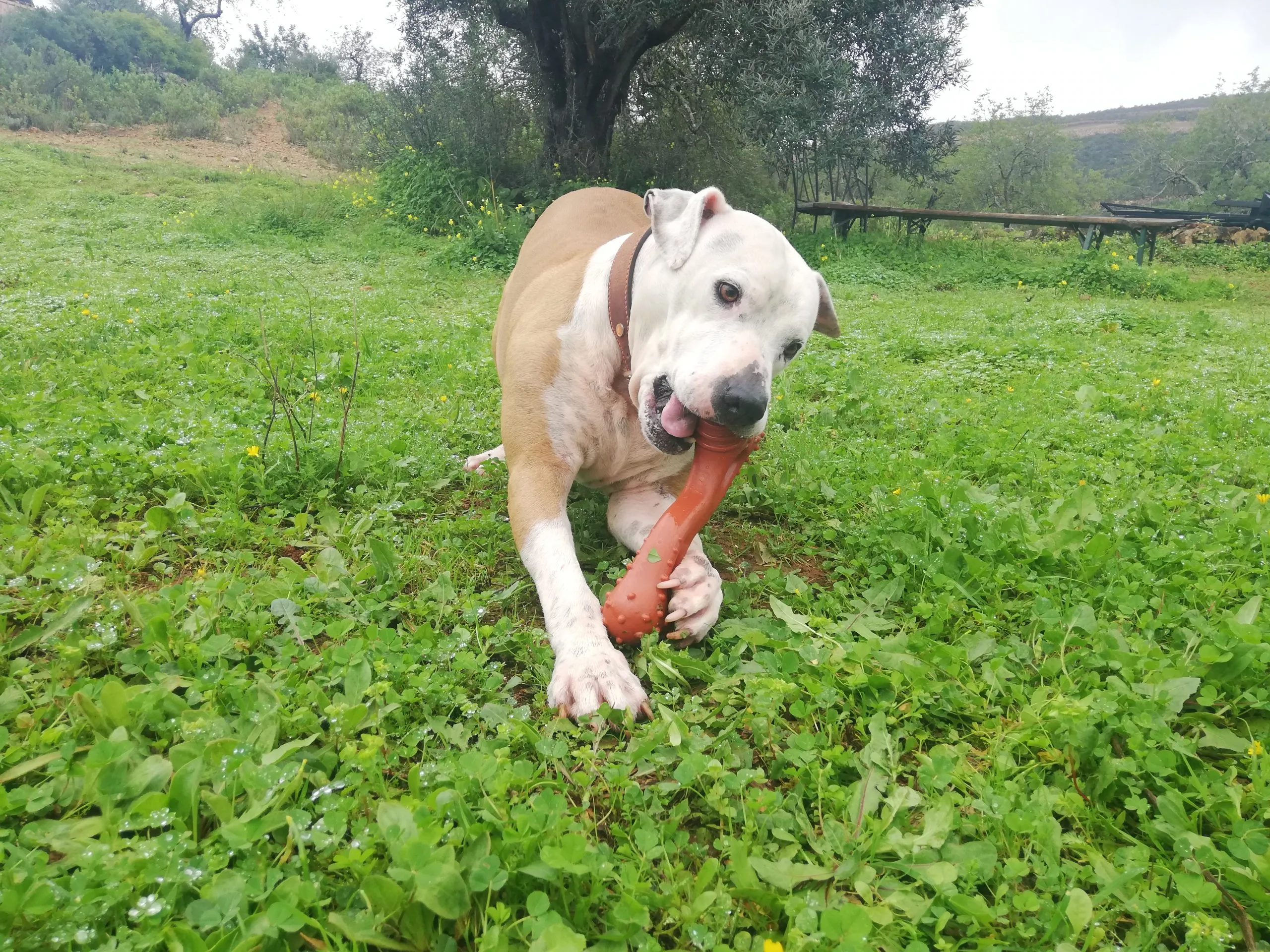 Nero, a white Pitbull, intensely chewing on the Nylabone toy
Nero, a white Pitbull, intensely chewing on the Nylabone toy
Even Maya, a 3-year-old dog who was abandoned and initially terrified of humans, took an immediate liking to this Nylabone. Having likely had no toys in her early life, she showed no confusion or hesitation, instantly engaging with it. Maya thoroughly enjoyed a good chew and running around with the toy in her mouth, often inciting playful chases from other dogs like Max. This toy is also remarkably easy to clean (if we can pry it away from an enthusiastic dog!), and it never loses its enticing flavor. For owners who prioritize cleanliness, this bone is a dream—absolutely no mess or lingering odors.
Black Nero, a Cane Corso cross, is renowned for his powerful chewing capabilities. He has been known to effortlessly chew through large tree trunks and even bend strong fencing materials when anxious. Despite his formidable chewing style and hours of dedicated effort, this Nylabone proved to be Black Nero-proof, much to our delight and his enjoyment. After extensive chewing sessions, there was hardly a single tooth mark on the bone, making it a strong contender among best durable dog toys for aggressive chewers.
The Details
This Nylabone toy is bison-flavored throughout (also available in chicken and turkey), designed to encourage prolonged chewing. It features raised nubs that aid in cleaning teeth and gums, promoting good dental hygiene. The toy is made from safe, non-toxic materials. It measures 30.48 x 13.97 x 5.08 cm and weighs 485 grams, specifically designed for dogs weighing 23 kg and above.
Summary
Every single dog at our shelter would wholeheartedly recommend this Nylabone. Their collective advice is clear: if you have a dog that loves to chew, gets easily bored, and requires a truly tasty and durable toy to sink their teeth into, this is an excellent choice.
Kong Rewards Ball
The Kong Rewards Ball initially received a less enthusiastic reception from our canine reviewers compared to some of the other toys. However, this reaction was short-lived. The concept of combining a toy for play with a treat dispenser that can keep dogs amused for hours is undeniably clever. From a human perspective, inserting treats was straightforward. Unlike some more complicated treat dispensers, our dogs didn’t need excessive “brain power” or effort to access their rewards.
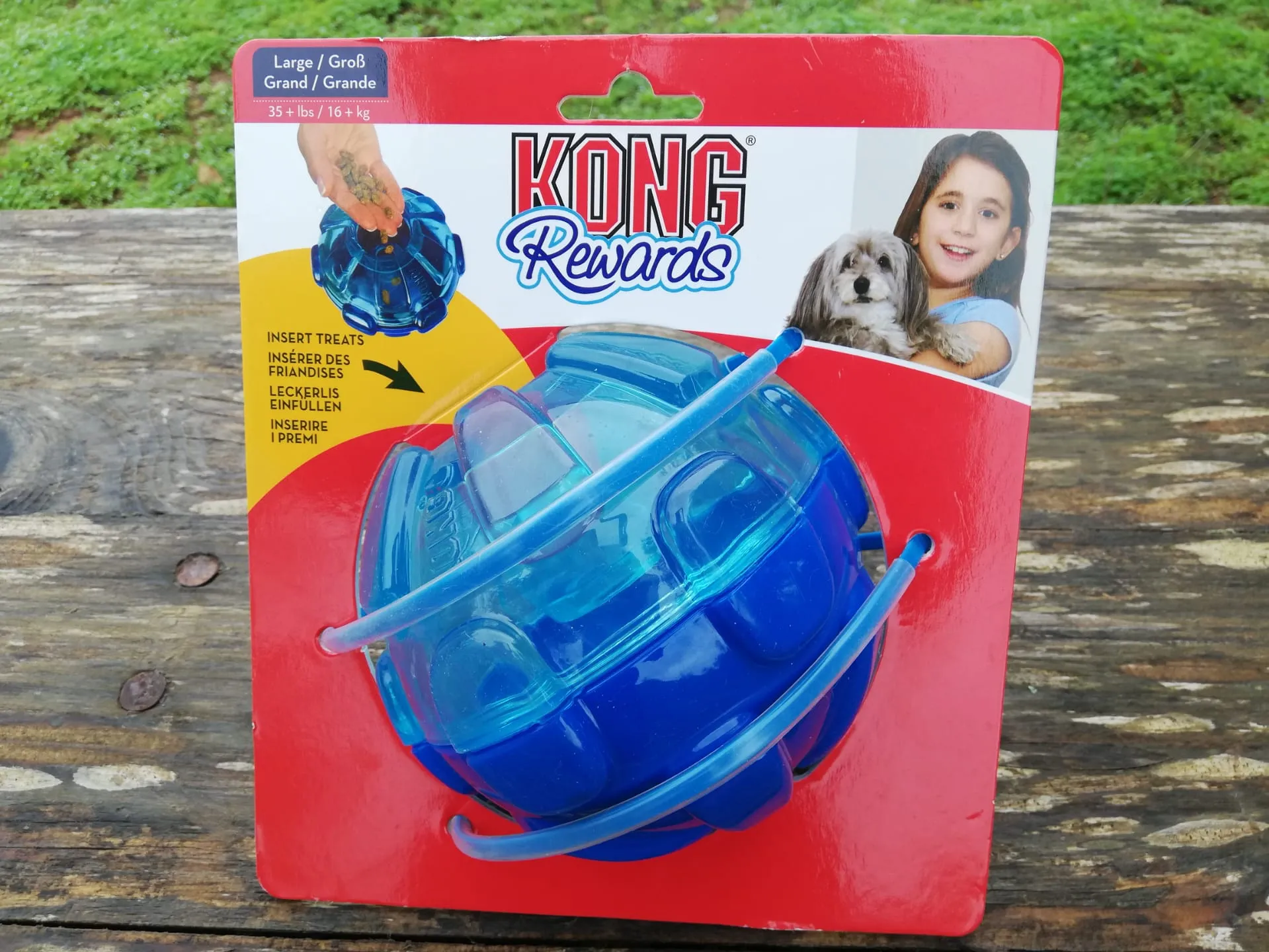 The Kong Rewards Ball, a treat-dispensing dog toy
The Kong Rewards Ball, a treat-dispensing dog toy
Interestingly, the dogs seemed to favor the soft, bouncy rubbery side of the ball more than the treat-dispensing aspect. Jean, in particular, absolutely adored this toy. He would spend hours chewing on the rubbery side before burying it and then eagerly digging it up again. His best friend, Komo, barely got a look in, much to his dismay! It’s clear that for toys for aggressive chewing dogs uk that also offer interactive play, this one is a hit.
From the enormous Jambo to the petite Star, every dog at the shelter had a chance to play and chew. We found not a single tooth mark on the ball, and all the treats were successfully dispensed. This is a definitive sign of an effective and simple treat dispenser.
The Details
The Kong Rewards Ball measures 12.7 x 12.7 x 12.07 cm and weighs 417 grams. It is designed for dogs weighing 16 kg and above. The toy is made from durable Kong rubber, built to withstand significant chewing and bouncing.
Summary
Our dogs concluded that this is an excellent all-around toy, skillfully combining two of their favorite activities: play and food. It’s a durable and tough toy that can withstand extensive chewing, vigorous bouncing, and interactive play, all while functioning as a simple and effective treat dispenser.
CyunCmay Indestructible Dog Toy XL Bone
The CyunCmay Indestructible Dog Toy XL Bone initially generated the most excitement among our dogs upon unboxing. However, this enthusiasm came to an abrupt end once Black Nero, our formidable chewer, got his paws and teeth into it. While he did have a great deal of fun for about 30 minutes, engaging in tug-of-war with its end handles, enjoying a good chew, and fetching it from the lake, the toy’s soft, rubbery, and pliable material raised our concerns about its durability.
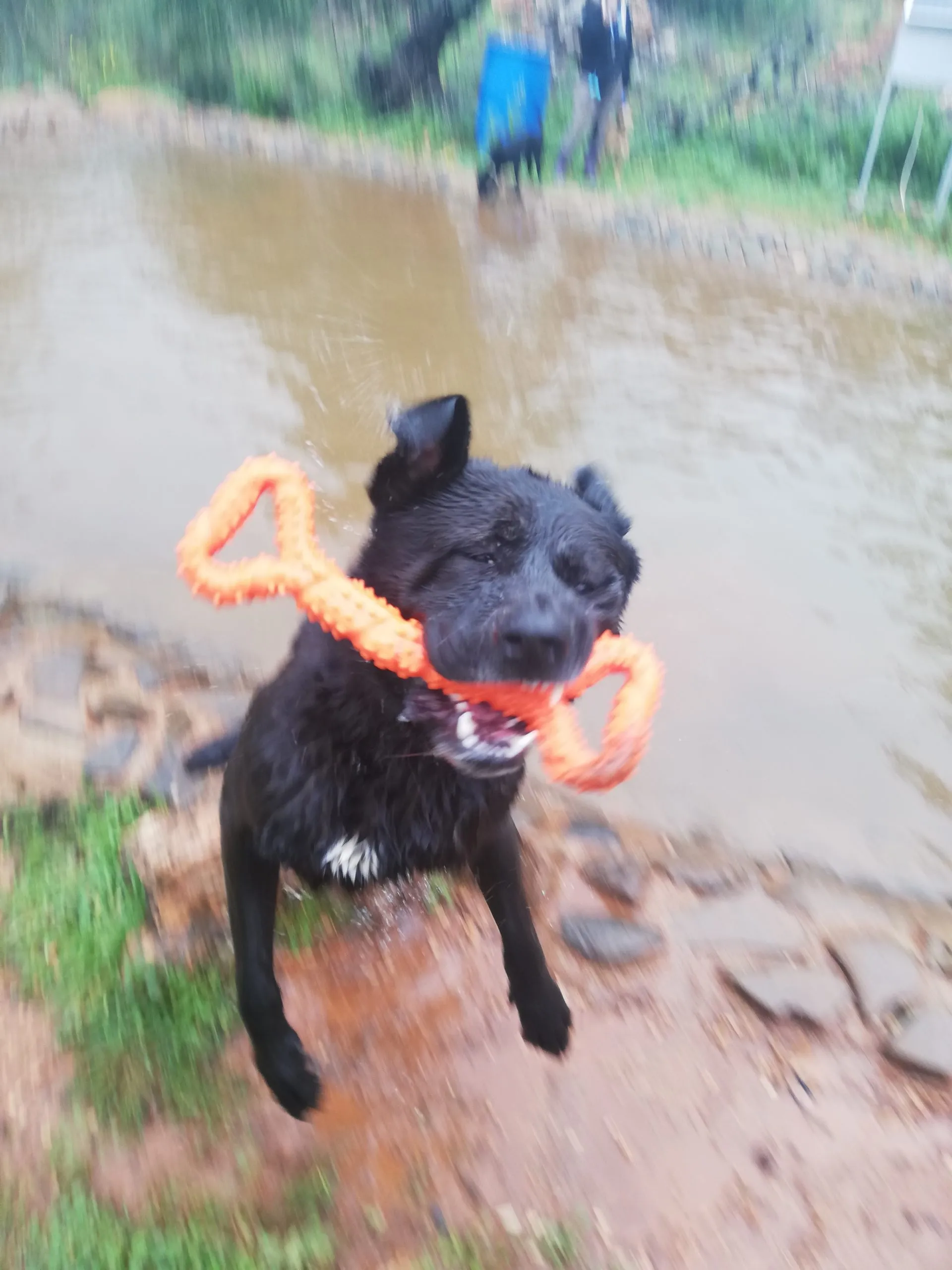 Black Nero energetically playing with the orange CyunCmay bone
Black Nero energetically playing with the orange CyunCmay bone
Unfortunately, Black Nero quickly proved our fears founded. With a big sigh, we observed the damage within a mere 30 minutes. The results, clearly visible in the accompanying photos, showed significant teeth marks and the bone almost splitting in two. This demonstrates that despite being advertised as “indestructible,” its material wasn’t robust enough for serious chewers, which is a crucial consideration for anyone seeking best chew toys for aggressive chewers dogs.
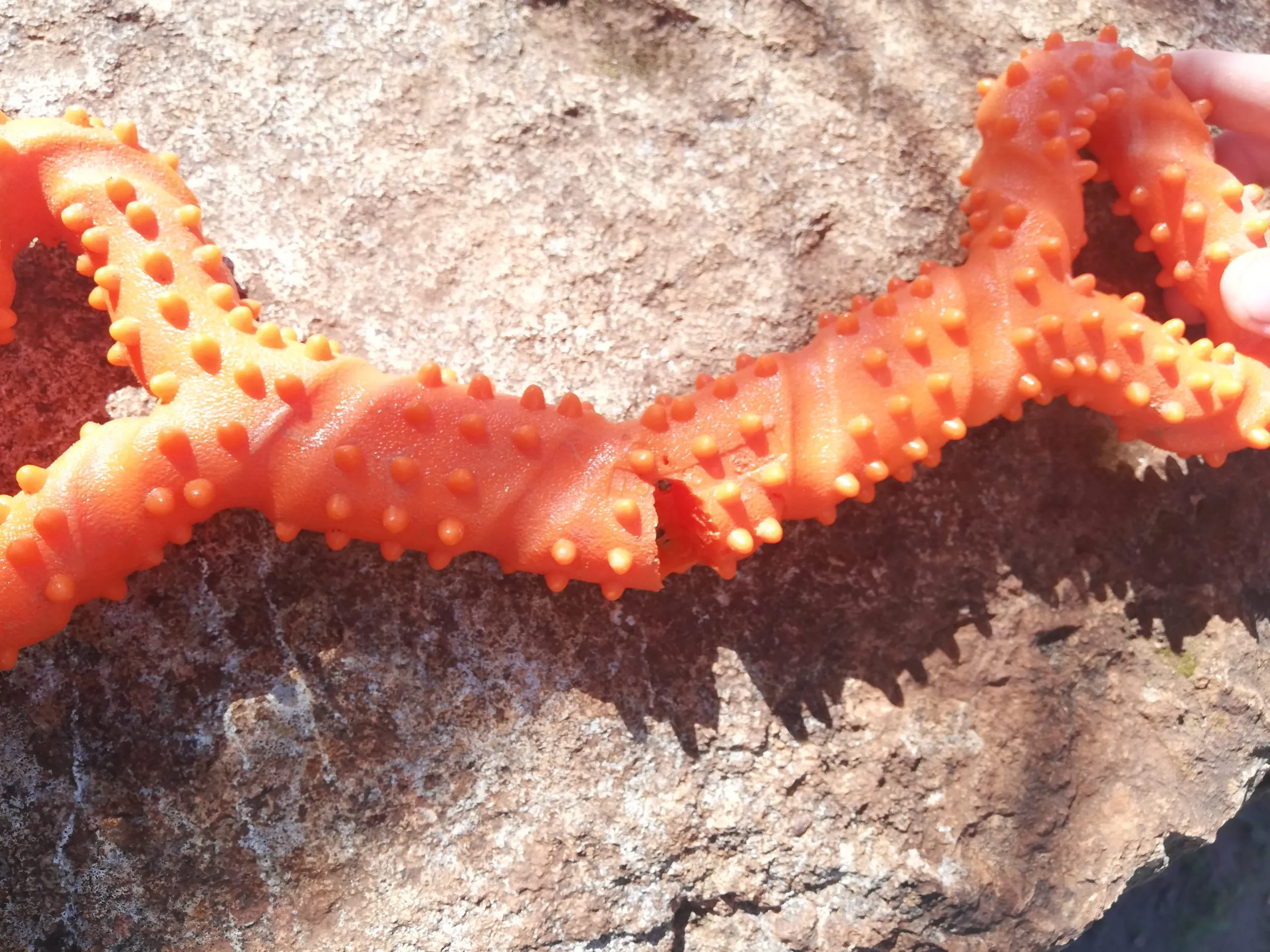 Close-up of the CyunCmay bone showing significant teeth marks and damage
Close-up of the CyunCmay bone showing significant teeth marks and damage
The Details
The CyunCmay XL Bone measures 32.9 x 12.2 x 3.8 cm and weighs 330 grams. It is made from TPR (Thermoplastic Rubber), described as environmentally friendly, chemical-smell-free, safe, and non-toxic. Its surface is designed to help clean a dog’s teeth and control plaque and tartar.
Summary
Despite being marketed as strong and durable and suitable for medium to large dogs, our dogs’ testing results speak volumes. Indestructible? No. Fun for a short while? Yes. If you’re searching for a toy for dogs that like to chew that won’t be destroyed in minutes, this is not the toy for your dog. However, if you’re looking for a fun toy primarily for retrieving and interactive play, where it’s not left unattended for prolonged chewing, this toy was quite popular with our dogs, inspiring them to run around and play. Our dogs were visibly disappointed when their fun with this toy was so short-lived.
HETOO Indestructible Squeaky Dental Care Dog Toy
Admittedly, the primary purpose of the HETOO Indestructible Squeaky Dental Care Dog Toy is to clean a dog’s teeth. However, it was met with such unenthusiastic reactions from our expert reviewers that we were left quite perplexed. Even its squeak failed to generate much excitement, though Maya did run and hide upon hearing the strange noise emanating from the peculiar-looking red object. Being the brave girl she is, Maya eventually gave it another inspection.
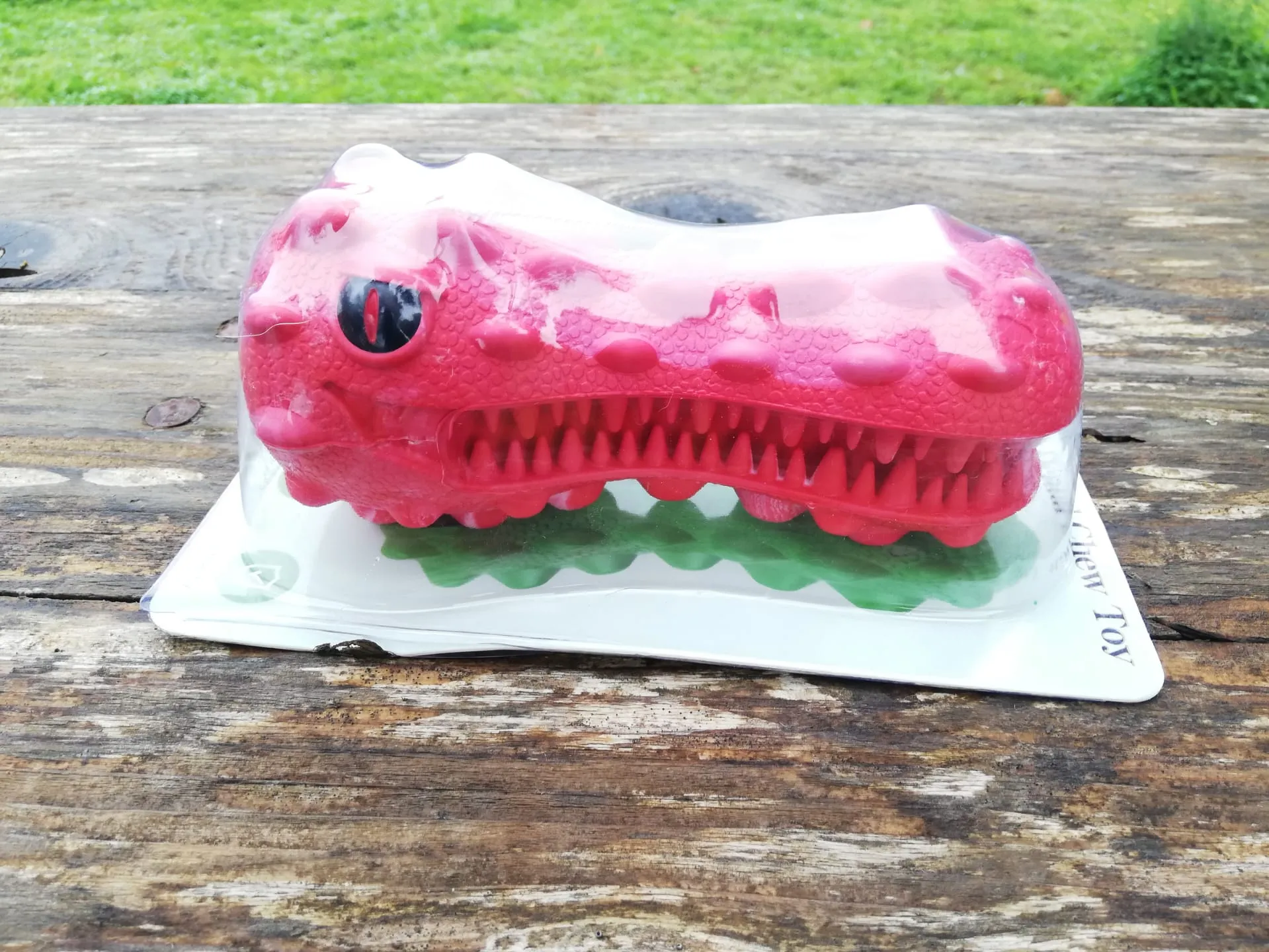 The HETOO Indestructible Squeaky Dental Care Dog Toy, a red rubber toy
The HETOO Indestructible Squeaky Dental Care Dog Toy, a red rubber toy
To try and make this “toy” more appealing, we smeared peanut butter within its grooves to encourage our reviewers to chew it. This strategy kept Maya interested for only a few minutes before she wandered off, leaving the toy behind. This toy definitely didn’t make the cut for best chew toys for aggressive puppy chewers, or any aggressive chewers for that matter.
The Details
The HETOO toy is made from natural rubber and measures 12.7 x 12.7 x 12.07 cm, weighing 417 grams.
Summary
The HETOO toy failed to excite our dogs or keep them entertained for more than a few minutes. And yes, it squeaks—annoyingly so for us humans! Black Nero and Maya were the only ones who showed any fleeting interest, and even that was very brief. For its primary purpose as a dental aid, it needed more engagement.
Kong Wobbler Interactive Treat Dispensing Dog Toy
The dogs’ reaction to the Kong Wobbler was truly hilarious. Was it a bird, a plane, or perhaps a UFO? Its sheer size likely contributed to their initial bewilderment. Unlike many other Kong treat toys, this one is made from a harder plastic polymer rather than rubber. From a human perspective, the twist-off lid makes it incredibly easy to fill with treats. However, our canine experts initially struggled with this toy. They wanted to play and understood there were treats inside, but couldn’t quite figure out how to get them out.
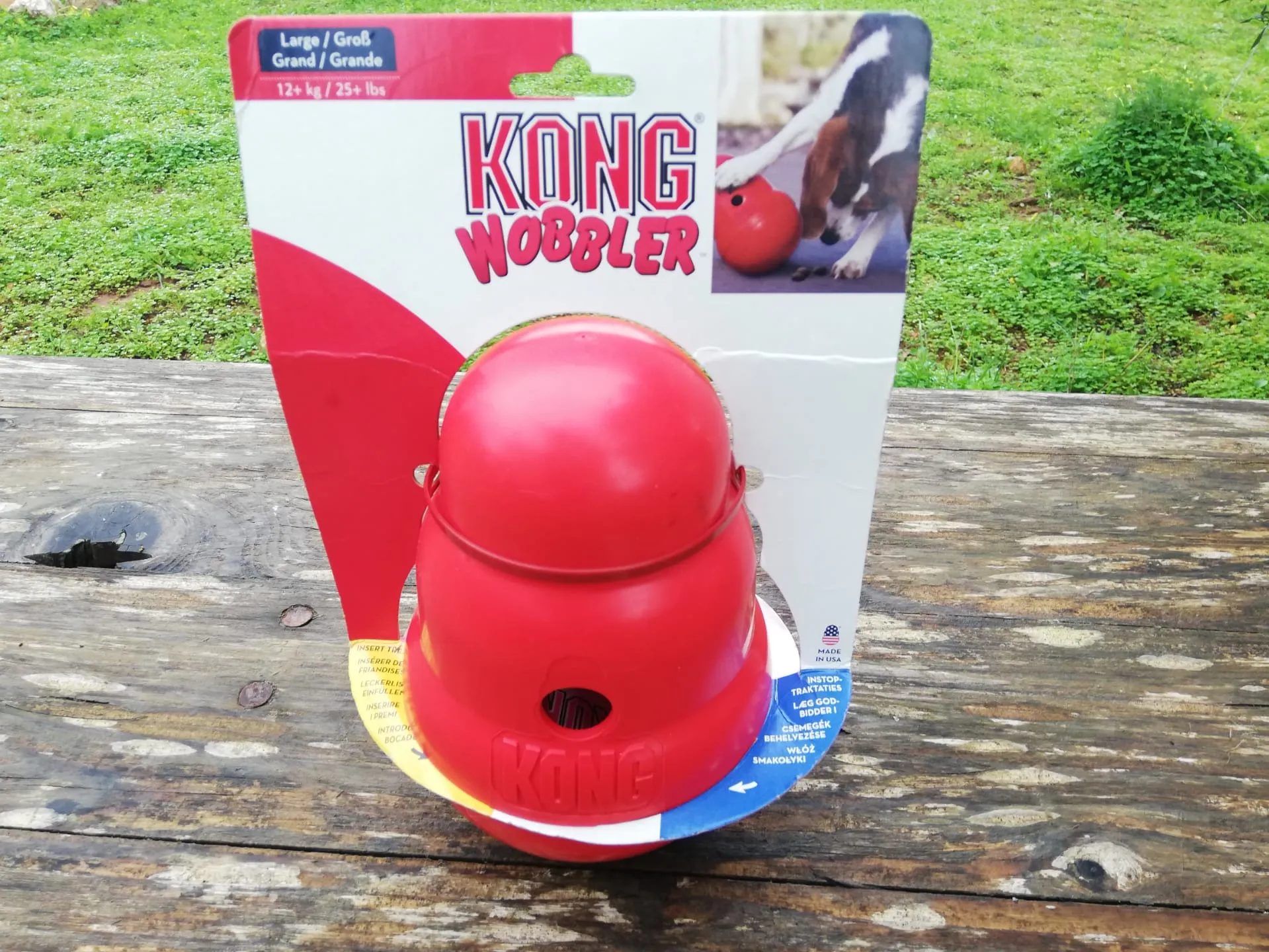 The Kong Wobbler Interactive Treat Dispensing Dog Toy
The Kong Wobbler Interactive Treat Dispensing Dog Toy
It dawned on us humans that this Kong Wobbler functions best on smooth surfaces, not the stone pebbly ground found in the dog kennels. Additionally, we realized that the treat size needed to be compatible with the dispenser hole—a simple oversight! Once these adjustments were made, Pebbles, among others, really started to engage with it, bumping and nudging it to release treats.
The Details
The Kong Wobbler is made from a plastic polymer. It measures approximately 13 cm in diameter and 19 cm in height, weighing 485 grams. It is designed for dogs weighing 12 kg and above and has a maximum filling capacity of 250 grams.
Summary
Once the dogs grasped the mechanics of this toy, and we humans realized the importance of using it on a smooth surface and selecting appropriately sized treats, this Kong was a resounding success. Its large size makes it difficult for dogs to pick up in their mouths, which might be a benefit as it reduces the chances of them getting their teeth firmly stuck in it and potentially destroying it. Indestructible? According to our dogs, yes. Easy to use? Once everyone understood the system, yes! It’s a fantastic interactive toy for mental stimulation and slow feeding.
Conclusion – Our Dog’s Verdict
After much deliberation, numerous serious-looking meetings, and a cacophony of barks and wagging tails (we won’t name the loudest!), our dogs have reached their final verdict on these five “indestructible” toys.
For dogs that truly love to chew and need something robust, the Nylabone Extreme Tough Dog Chew Toy stands out. Its durability against even the most powerful chewers was impressive, and the lasting flavor kept our dogs engaged for extended periods.
For those seeking an interactive toy that combines play with rewarding treats, the Kong Rewards Ball and the Kong Wobbler were clear winners. The Rewards Ball offered satisfying chewiness and an easy treat release, while the Wobbler provided excellent mental stimulation and proved indestructible on appropriate surfaces.
The CyunCmay Indestructible Dog Toy XL Bone proved to be fun for short, supervised play sessions, especially fetching, but ultimately failed to live up to its “indestructible” claim for strong chewers. The HETOO Indestructible Squeaky Dental Care Dog Toy unfortunately struggled to capture our dogs’ interest, even with the addition of peanut butter, highlighting that a toy’s primary purpose might not always translate to canine appeal.
When choosing Toys For Dogs That Like To Chew, prioritize proven durability, engaging features, and the specific play style of your dog. Always supervise your dog with new toys and opt for products from reputable brands known for their quality. Remember, a happy chewer is a well-behaved chewer!
